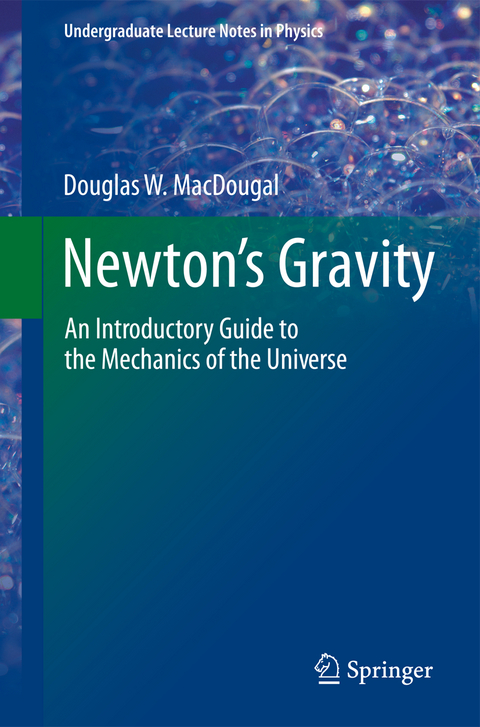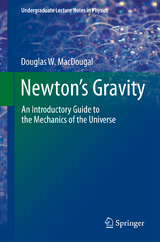Newton's Gravity
Springer-Verlag New York Inc.
978-1-4614-5443-4 (ISBN)
“Newton’s Gravity” conveys the power of simple mathematics to tell the fundamental truth about nature. Many people, for example, know the tides are caused by the pull of the Moon and to a lesser extent the Sun. But very few can explain exactly how and why that happens. Fewer still can calculate the actual pulls of the Moon and Sun on the oceans. This book shows in clear detail how to do this with simple tools. It uniquely crosses disciplines – history, astronomy, physics and mathematics – and takes pains to explain things frequently passed over or taken for granted in other books. Using a problem-based approach, “Newton’s Gravity” explores the surprisingly basic mathematics behind gravity, the most fundamental force that governs the movements of satellites, planets, and the stars.
Author Douglas W. MacDougal uses actual problems from the history of astronomy, as well as original examples, to deepen understanding of how discoveries were made and what they mean. “Newton’s Gravity” concentrates strongly on the development of the science of orbital motion, beginning with Galileo, Kepler, and Newton, each of whom is prominently represented. Quotes and problems from Galileo’s Dialogs Concerning Two New Sciences and particularly Newton’s Principia help the reader get inside the mind of those thinkers and see the problems as they saw them, and experience their concise and typically eloquent writing.
This book enables students and curious minds to explore the mysteries of celestial motion without having to know advanced mathematics. It will whet the reader’s curiosity to explore further and provide him or her the tools (mathematical or physical) to do so.
Douglas W. MacDougal has a degree in mathematics, with a minor in physics, from the University of Vermont, and is an adjunct professor at Portland State University teaching celestial mechanics and (previously) astronomy. For many years he also taught courses in astronomy and mathematics in Portland’s Saturday Academy, whose classes typically include gifted middle school and high school students. MacDougal is a lifelong amateur astronomer, and he teaches every summer at the Oregon Museum of Science and Industry (OMSI) Astronomy Camp in the Oregon desert, showing students the stars through his 18-inch telescope.
Preface.- Chapter 1: Introduction - The Twin Mysteries of Mass.- Chapter 2: Galileo's Great Discovery - How Things Fall.- Chapter 3: Christiaan Huygens' Remarkable Pendulum.- Chapter 4: The Geometry of the Solar System - Kepler's Laws of Planetary Motion.- Chapter 5: How the Moon Falls Toward the Earth (but keeps missing it).- Chapter 6: Newton's Moon Test.- Chapter 7: Newton Demonstrate How an Inverse Square Law Could Explain Planetary Motions.- Chapter 8: Newton's Master Stroke - The Universal Law of Gravitation.- Chapter 9: Determining the Value of g on Earth.- Chapter 10: A Binary System Close to Home - How the Moon and Earth Orbit Each Other.- Chapter 11: Using Kepler's Third Law to Find the Masses of Stars and Planets.- Chapter 12: Motion in Elliptical Orbits.- Chapter 13: The Energy and Geometry of Orbits.- Chapter 14: Introduction to Spaceflight.- Chapter 15: Getting Oriented - The Sun, the Earth, and the Ecliptic Planet.- Chapter 16: An Introduction to Kepler's Problem - Finding the True Anomaly of an Orbiting Body.- Chapter 17: What Causes the Tides?.- Chapter 18: Moon, Rings, and the Ripping Forces of Tides.- Chapter 19: Hovering in Space - Those Mysterious Langrangian Points.- Appendix: Solutions.- Index.
| Reihe/Serie | Undergraduate Lecture Notes in Physics |
|---|---|
| Zusatzinfo | 69 Illustrations, color; 9 Illustrations, black and white; XIX, 433 p. 78 illus., 69 illus. in color. |
| Verlagsort | New York, NY |
| Sprache | englisch |
| Maße | 155 x 235 mm |
| Themenwelt | Mathematik / Informatik ► Mathematik ► Angewandte Mathematik |
| Naturwissenschaften ► Geowissenschaften ► Geologie | |
| Naturwissenschaften ► Physik / Astronomie ► Astronomie / Astrophysik | |
| Schlagworte | Celestial mechanics • Celestial motion • history of astronomy • Inverse square laq • Kepler's laws • Law of Planetary motion • Laws of gravity • Newton's laws • Orbital motion • Orbital plane |
| ISBN-10 | 1-4614-5443-3 / 1461454433 |
| ISBN-13 | 978-1-4614-5443-4 / 9781461454434 |
| Zustand | Neuware |
| Haben Sie eine Frage zum Produkt? |
aus dem Bereich




